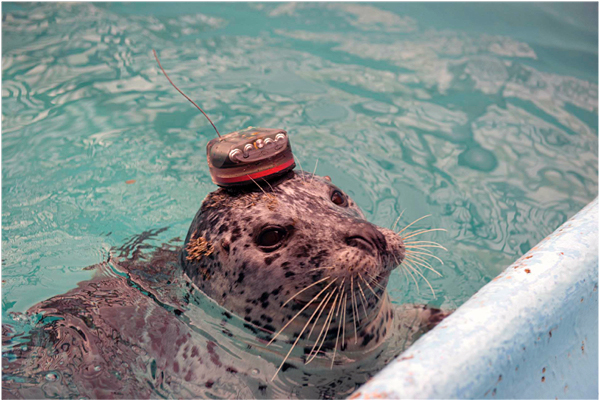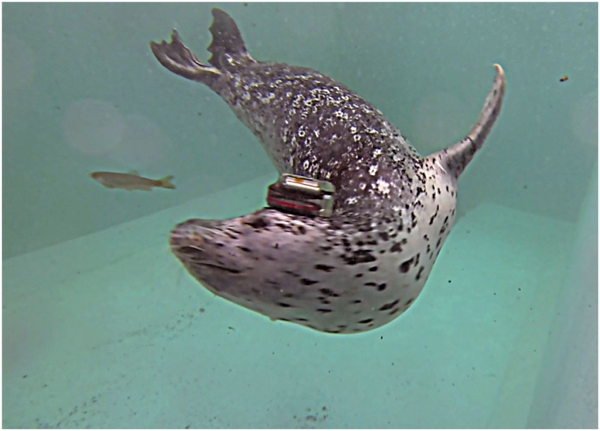Counting salmon smolts as they pass down the throat of a seal one fish at a time
Have you ever used a key fob to open a locked door, or driven through a toll booth without stopping because you had an ID card on your windshield? If so, chances are you were using Radio Frequency Identification (RFID) technology. These simple devices transmit a weak radio signal with a unique identification number as they pass near an RFID scanner. It allows the door to grant you access to the room, and toll booths to charge you the appropriate fee.

The harbor seal Hermes wearing a fish-tag reader that contains an antennae, batteries, and an electronics board. Neil Fisher photo (Vancouver Aquarium)
UBC Researchers, Austen Thomas and Brian Battaile, are developing this same RFID technology to identify and record how many salmon smolts are being eaten by harbor seals in the Strait of Georgia. They have been developing a satellite tag containing an RFID scanner with Wildlife Computers that can be carried on the head of a seal to read RFID microchips that are regularly implanted in salmon smolts. Fisheries managers implant PIT (Passive Integrated Transponders) tags, which contain RFID microchips, in young salmon to monitor survival during downstream migration. These are the same types of tags used by veterinarians to keep track of dogs and cats.
Scanners placed in rivers can log each time a salmon smolt carrying a PIT tag passes by, and are used to determine how many smolts survive. This led Thomas and Battaile to ask, “Why don’t we put the scanner on a seal?” What seemed like a crazy idea at the time has turned into a viable method for estimating how many smolts are consumed by seals.
With funding from the Pacific Salmon Foundation, Thomas and Battaile tested the first prototype RFID tag —a head mounted PIT tag scanner for seals—that can detect each ingested salmon smolt and transmit that information via satellite.

Hermes approaching a young coho salmon that has a tag inserted into its abdominal cavity. The fish-tag reader on Hermes’ head will record the number of the tag as it passes down the seal’s throat.
Thomas and Battaile worked with Vancouver Aquarium staff on a feasibility study that determined which types of PIT tags could be detected, and how long the battery would last. They fed Hermes (one of the Aquarium’s harbor seals) coho salmon smolts that had been implanted with different types of PIT tags, and measured the detection rates under different conditions. The prototype tag was held on the seal’s head by a strip of Velcro, and was removed between trials by the trainers (who trained Hermes to wear his hat with pride!).
The research team found that the RFID tag was able to detect when the seal ate the larger salmon smolts (i.e., coho and steelhead), and that the batteries lasted several weeks, sufficient to cover the typical smolt outmigration window. Results were presented at the recent Salish Sea Ecosystem Conference in Seattle, Washington.
The next step is to refine the technology so that other species of salmon smolts (such as chinook) can also be detected. With any luck, you may see a harbor seal swimming around the Strait of Georgia with a jaunty tag-reading hat in 2015!
Austen Thomas is a Ph.D. Candidate at UBC’s Marine Mammal Research Unit.
Brian Battaile is a Researcher for the Marine Mammal Research Consortium.
